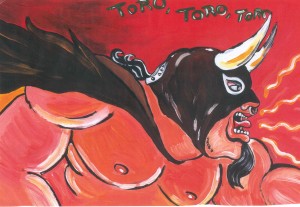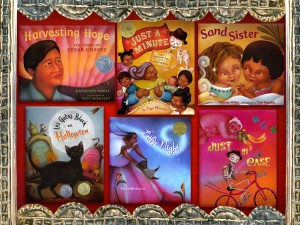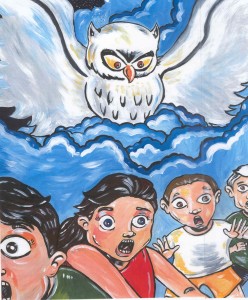by Janine M. Schall, University of Texas-Pan American, Edinburg, TX
This is the last of a four part interview with author and illustrator Xavier Garza, 2005 América’s Award Honor Book winner. This interview was conducted electronically by Janine Schall.

The luchador "El Toro" from Lucha Libre-The Man in the Silver Mask
Janine: The illustrations in your books are striking and attractive to kids. Juan and the Chupacabras was illustrated by someone else. Was that a publisher’s decision? Were you able to collaborate with April Ward or was she given your text to work with on her own?
Xavier:That was strictly the publisher’s decision. At the time that I got the contract for Juan and the Chupacabras, my book Lucha Libre still hadn’t come out. I was viewed as not having any experience in the field of children’s book illustrations, which I have to admit is very different from just being able to draw and paint. A lot of work goes into producing these illustrations, and you have to learn to work with art editors. Making illustrations for a book isn’t a one person show. After Lucha Libre came out and received very favorable reviews for the art as well as the story, it opened the door for me to ask to illustrate all of my own books. Zulema and the Witch Owl was also done with Arte Público, and featured my own illustrations. I love my book Juan and the Chupacabras, but I would be lying if I said that I don’t wish that I had done the illustrations myself. I however must say that April Ward did a wonderful job working on the book. Her art alongside the sketches done by Felipe Davalos who was the original illustrator of the book, but who had to drop out of the project due to scheduling complications, were truly beautiful. I have never met April Ward, and this isn’t uncommon when it comes to an author and an illustrator working on a book. They are often kept apart so as to give the illustrator more freedom to turn the writer’s vision into his or her own.
Continue reading →




 This is the third of a four part interview with author and illustrator Xavier Garza, 2005 América’s Award Honor Book winner. This interview was conducted electronically by Janine Schall.
This is the third of a four part interview with author and illustrator Xavier Garza, 2005 América’s Award Honor Book winner. This interview was conducted electronically by Janine Schall.
 This is the first of a four part interview with Xavier Garza, author of several children’s books, including Lucha Libre: The Man in the Silver Mask, 2005 América’s Award Honor Book. Xavier was born and raised in Rio Grande City, a small town on the Texas/Mexico border. His work draws upon the cultural and linguistic influences of life in the Rio Grande Valley. Xavier now lives in San Antonio with his wife and son. This interview was conducted electronically.
This is the first of a four part interview with Xavier Garza, author of several children’s books, including Lucha Libre: The Man in the Silver Mask, 2005 América’s Award Honor Book. Xavier was born and raised in Rio Grande City, a small town on the Texas/Mexico border. His work draws upon the cultural and linguistic influences of life in the Rio Grande Valley. Xavier now lives in San Antonio with his wife and son. This interview was conducted electronically.